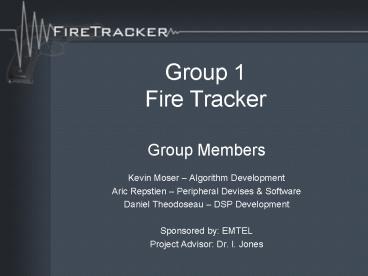Group 1 Fire Tracker - PowerPoint PPT Presentation
1 / 43
Title:
Group 1 Fire Tracker
Description:
Fire Tracker is a gun shot detection and location system based upon ... 2) Beretta, Model: 92FS, 9mm Luger (Handgun) Speer Lawman Ammunition, 9mm Luger, 155 GR. ... – PowerPoint PPT presentation
Number of Views:22
Avg rating:3.0/5.0
Title: Group 1 Fire Tracker
1
Group 1Fire Tracker
- Group Members
- Kevin Moser Algorithm Development
- Aric Repstien Peripheral Devises Software
- Daniel Theodoseau DSP Development
- Sponsored by EMTEL
- Project Advisor Dr. l. Jones
2
Project Description
- Fire Tracker is a gun shot detection and
location system based upon the audio signatures
of various firearms. The device will detect a
shot being fired, and relay data to a computer
system for further data analysis, such as event
triangulation.
3
Goals
- Proof of concept
- Various Weapon types
- Similar Non-Event Rejection
- Global Positioning System (GPS)
- Event Data Tags
- Serial Data Interface
4
Design
- Phase 1
- Data Acquisition/Analysis
- Phase 2
- Hardware/Software Prototyping
5
Phase 1
- Data Collection
- Data Analysis
- Wavelet Transform
- Statistical Analysis
6
Data Collection
- 1) ArmaLite Inc., Model AR-15, 223 (Rifle)
- PMC Target Ammo, 223 Rem, 55 GR., FMJ-BT
- 2) Beretta, Model 92FS, 9mm Luger (Handgun)
- Speer Lawman Ammunition, 9mm Luger, 155 GR., FMJ
- 3) Remington, Model 870 Express, 12 Gauge
(Shotgun) - Estate Cartridge Inc., 12 Gauge, 2 3/4 L, 3 1/2
Dr. Eq., 1 oz. Shot, 7 1/2 shot
7
Data Analysis
- Fast Fourier Transform
- Determines the frequency content of the signals
8
Frequency Comparison
Green Shotgun Blue Handgun Red Rifle
9
Frequency Comparison
Green Rifle 1 Blue Rifle 2 Red Rifle 3
10
SamplingRate
- Based on the range of frequencies from o-4 kHz,
our sampling rate was a determined from the
following formula. - Therefore our sampling rate, FS 8 kHz.
11
WaveLet
- Wavelet Transform
- Time Variant Signals
- Analyzes a small section at a time using a
window. - Varies the Window Size
- Higher Accuracy
12
Wavelet Detail
- Definition A continuous wavelet transform is
defined as continuous due to the set of scales
and positions at which it operates. The
transform consists of shifting the analyzing
wavelet smoothly over the full domain of the
analyzed function.
13
Wavelet Formula
- The results of this transformation are the
wavelet coefficients, c. - c represents how closely correlated the wavelet
is with the windowed section of the signal. - The higher the c, the more the similarity between
the signal and wavelet.
14
Discrete Wavelet
- Based on Dyadic Scales and Positions (powers of
two) - Known as a two-channel subband coder.
- Yields a fast wavelet transform of the order N.
- Implemented as tree-structured digital filter
banks.
15
Family Shape
- Daubechies family db8.
- Low-scale, which allows the measurement of
rapidly changing details. - Analysis will be orthogonal.
- Used as a finite impulse response (fir) filter of
length 2n. - Asymmetric.
- Filter coefficients determined using Lagrange
filter.
16
Steps
- Step 1
- compute a lagrange filter p. This filter is
symmetric and of length 4N-1. - Extract a square root from p.
- Pa(N) 0 a(N-1) 00 a(1) 1 a(1) 0 a(2) 00
a(n)
17
Steps
- Step 2
- Determine the daubechies filter, w. This is
known as the scaling filter. - W is a minimum phase solution of p, based on the
roots of p. - For the db8 wavelet, the filter coefficients are
- w(1)0.0385 w(5)-0.0112 w(9)-0.0123
w(13)-0.0034 - w(2)0.2212 w(6)-0.2008 w(10)-0.0312
w(14)-0.0003 - w(3)0.4777 w(7)0.0003 w(11)0.0099
w(15)0.0005 - w(4)0.4139 w(8)0.0910 w(12)0.0062
w(16)-0.0001
18
Steps
- Step 3
- Compute the filters associated with the scaling
filter, w. - Lo_d decomposition low-pass filter.
- Hi_d decomposition high-pass filter.
- Lo_r reconstruction low-pass filter.
- Hi_r reconstruction high-pass filter.
- L0_rw/norm(w) hi_rqmf(lo_r)
- lo_dwrev(lo_r) hi_dwrev(hi_r)
- where wrev flips the filter coefficients
- qmf quadrature mirror filters
- hi_r(k)(-1)klo_r(2n1-k)
19
Steps
Step 4
20
Step
Step 4 (cont)
21
Statistical Analysis
- Event Detection
- Based on the increase of the input data
- Event Evaluation
- Outputs of wavelet transforms are compared using
statistical methods.
22
Phase 2
- Computer
- DSP Evaluation Board
- GPS Evaluation Board
- MIC, LOGAMP Filter
23
Hardware
24
Why DSP?
- Designed for signal processing applications.
- Ability to do real-time signal processing.
- Circular Hardware Buffer
- Optimize Branching Instructions
- Single Cycle Fetch Operations
25
DSP
- Texas Instruments DSP (TMS320C6711)
- 900 mflops
- 4kb program cache
- 4kb Data Cache
- 64kb Mapped Memory
- Multi-channel Buffered serial port
- Availability of Pre-assembled Evaluation Units
- User Friendly Development
26
DSP
- TMDS320006711 C6711 DSP Starter kit
- Development environment
- Interface for data and program loading.
- Interface for Monitoring Program Execution.
- Onboard A/D and D/A
- 16mb SDRAM
- Power is already supplied
27
DSP Layout
Provided by Texas Instruments
28
GPS
- Motorola M12 Evaluation Kit
- 12 Channel
- Positional accuracy1-5 meter
- Timing Accuracy 500ns
- Serial Data Communication
- 3v operating voltage
29
Log Amp
- Texas Instruments log102
- Exponential Nature of amplification
30
Filter
- 20hz to 8khz
- Simple Capacitive/resistive network yet to be
designed
31
Microphone
- Panasonic Series WM-61B
- 20hz to 20khz
- Omni-Directional
- 2v operating voltage
- Low Signal to Noise Ratio
- Low Cost
- Small Package Foot Print
32
Microphone
C 33 pf RL 2.2 kW
33
Software
34
Software Architecture
35
Program Flow
36
GPS Initialization
37
Event Detection
38
Time Position Acquisition
39
Event Analysis
40
Data Transmit
41
Budget
42
Schedule
43
Project Status

